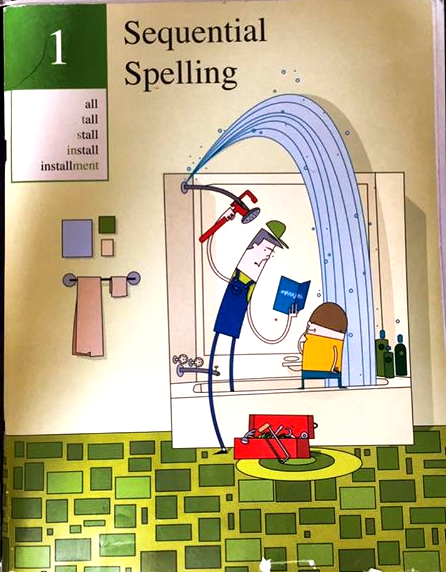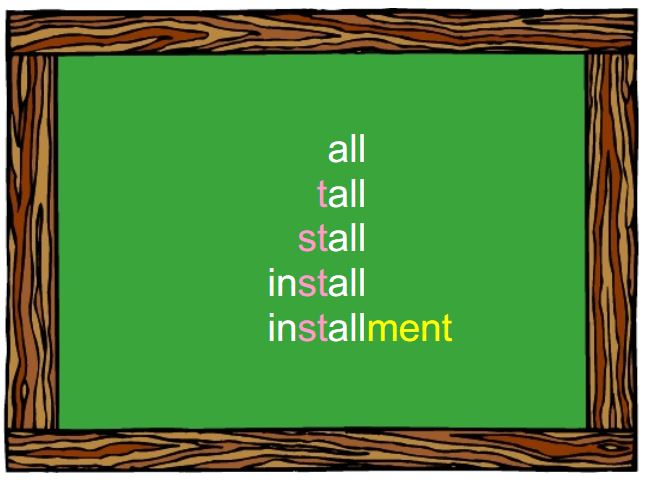Sequential Spelling

Sequential Spelling has a very unique history. Originally, it was designed for students with dyslexia and other learning disabilities. But the program quickly became popular among all student groups.
Author Don McCabe suffered from dyslexia. While he served in the Army Security Agency during the Korean War he was forced to either 1) learn Russian or 2) join the infantry in Korea. Faced with this choice, McCabe managed to overcome his dyslexia and learn Russian. When the war ended, he founded AVKO and spent his time teaching dyslexic students how to read, write, and spell through a unique multi-sensory approach that he developed.
Buy Sequential Spelling
Sequential Spelling comes in 7 progressive levels of difficulty. We (and Sequential Spelling) urge you to begin with Sequential Spelling 1 because, as the name suggests, each volume builds on the previous. Because Sequential Spelling uses a unique method (see below), these lower levels are essential.
Is the teacher's manual important or can I figure it out by just using the workbooks? -- You can't use the program without the teacher's manual. You need the teacher's manual for the word lists. You can complete Sequential Spelling without a student book. Your child(ren) will need to write write the words in a notebook. The exercises are very important for learning the meanings of the words.
Purchasing Sequential Spelling:
Sequential Spelling DVD-ROM
Sequential Spelling is available on DVD-ROM for computers! Which is better, the original, or the computer DVD? This is usually a personal and student preference. If you hear complaints about spelling workbooks, make sure to give the computer version a chance. Some people like it much better than the original. Personally, we love the Sequential Spelling app and the textbooks.Sequential Spelling review
It is always comforting to buy from a company that has a proven track record of research, results, and user satisfaction. AVKO has been researching English spelling for over 35 years. AVKO stands for Audio-Visual-Kinesthetic-Oral.
AVKO has published materials for every type of educator. Their, and our, recommendation is that every student starts with Sequential Spelling 1 -- assuming the child can read and spell at a 2nd grade level.
What makes Sequential Spelling a unique vocabulary and spelling program?
- Words are taught in relationship to one another, by groups of word families.
- It is hands on in the way that children discover rules for themselves by examining their relationships and commonalities. Complex spelling rules are ignored.
- Before a student begins to study words, they test themselves by attempting to spell each word correctly on their own.
- Sequential Spelling disregards grade levels when they select the word groups. They only select words based on their commonality.
What do these word lists look like?
Day 1: The first day is simple and short.
- in
- pin
- sin
- spin
But, once students make it to day three, they are introduced to a list of "in" words that is considerably longer. The list now includes:
- pinned
- skins
- twins
- plus more...
and the list begins to incorporate a new word family -- the "e" (i.e. b-e; sh-e) -- and starts to involve crossover words like begin.

Sequential Spelling uses words from easier "word families" as a foundation to build into more "important" words.
When a traditional spelling program introduces words, they do so through a vocabulary list. These vocab lists are usually chosen based on one of two criteria. Either they are words the authors assume the children will be encountering during their reading, or the author picks word lists with a theme in mind. Both of these methods will result in the student receiving an "incomplete" vocabulary education.
Sequential Spelling online
Sequential Spelling is now offering an online program. We still highly recommend the print program for a full and rich coverage of all learning styles for the highest levels of comprehension and retention.
Homeschool moms review Sequential Spelling
We used the books last year. This year, my boys (8 and 11) are using the online version. They like it, or at least complain less than normal about doing spelling. I like the format and the way that they categorize words. Yes, some of the words are a bit strange, but it's still making my kids better spellers. I really like that it doesn't let them move ahead until they get it right! It also tracks their progress, so less work for me
We have been using it off and on for about 6 months. I don't do a ton of spelling. But from what we have done we really like it. Some of the words are a bit weird. But I like the concept. Adding to the words to build on the spelling. How each word is called out and corrected, if need be, by the student right away. They can make their own corrections which helps it stick I believe. [source]
The Sequential Spelling method
Sequential Spelling uses every learning style over the course of their program.
- Verbally/Auditory/Audio - Usually the word is spoken verbally in the context of a sentence.
- Kinesthetic/Hands-on - The student tries to spell the word.
- Visual/Oral/Hands-on - Colored white board markers are used to distinguish the correct spelling and differentiate between word groups.
- Kinesthetic - Students then correct the mistakes they made in step number two.
- The student's mistakes are corrected instantly instead of dragging on for days and weeks at a time.
- Testing - Sequential Spelling does not utilize a traditional method of testing. Tests are used as learning tools, NOT as a way to grade or evaluate a student.
For the parent that needs or wants grades, 5 quite evenly spaced written tests (that can easily be reproduced) are built-in as options.
The books are progressive but are not strongly associated with a grade level. You can start any grade level child at Level 1. From there, you can progress through the books in order. Because Sequential Spelling is, well, "sequential," students usually need to start at Level 1. Sequential Spelling recommends that before children start Level 1 that they are reading at a second-grade level. Some first graders can start Level 1 and some students will need to wait.
Free samples of Sequential Spelling
Get a peek inside the pages!
- View 16 pages of Sequential Spelling 1 for free by clicking here.








